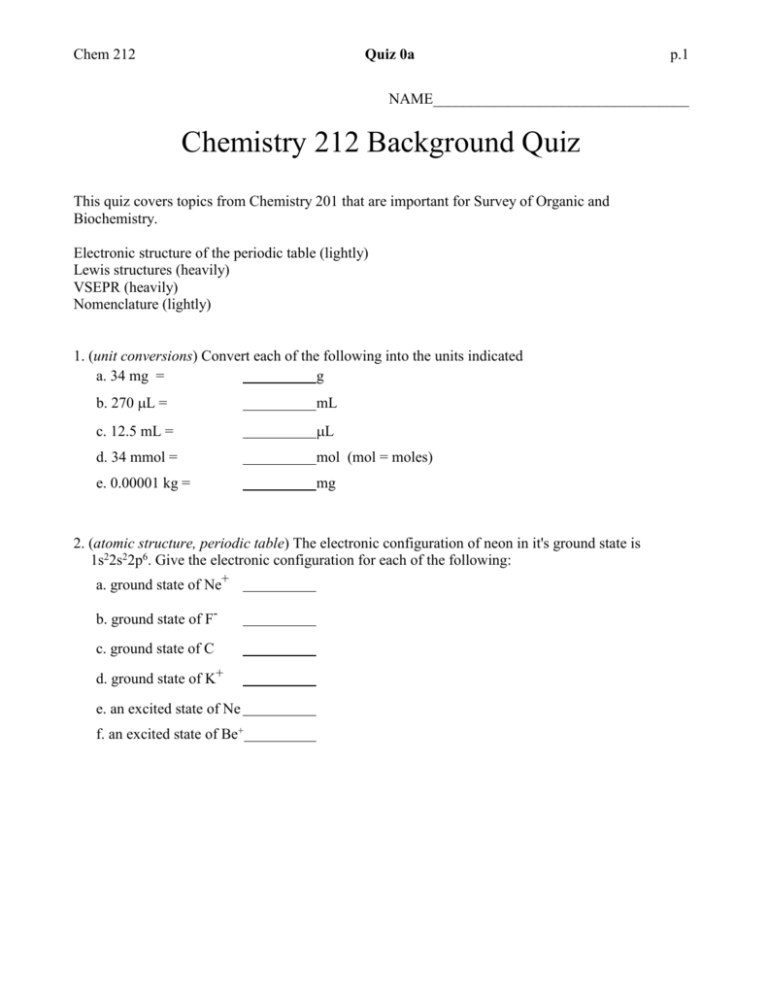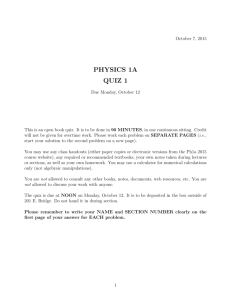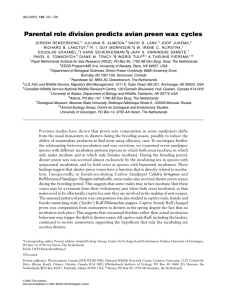00a
advertisement

Chem 212 Quiz 0a p.1 NAME__________________________________ Chemistry 212 Background Quiz This quiz covers topics from Chemistry 201 that are important for Survey of Organic and Biochemistry. Electronic structure of the periodic table (lightly) Lewis structures (heavily) VSEPR (heavily) Nomenclature (lightly) 1. (unit conversions) Convert each of the following into the units indicated a. 34 mg = g b. 270 L = mL c. 12.5 mL = L d. 34 mmol = mol (mol = moles) e. 0.00001 kg = mg 2. (atomic structure, periodic table) The electronic configuration of neon in it's ground state is 1s22s22p6. Give the electronic configuration for each of the following: a. ground state of Ne+ b. ground state of Fc. ground state of C d. ground state of K+ e. an excited state of Ne f. an excited state of Be+ Chem 212 Quiz 0a p.2 3. (Lewis structures, VSEPR) Draw Lewis dot diagrams (Lewis structures) for each of the following molecules, and predict the shape of the molecule as one of the following: a) tetrahedral, b) tetrahedral/triangular pyramidal, c) tetrahedral/bent, d) triangular planar, e) triangular planar/bent, e) linear. a. CH4 d. NH3 b. H2O e. BF3 c. H2Se f. BeH2 4. (solutions) Which of the following diagrams best represents the molecular concept of sodium chloride dissolved in water? Explain what is wrong for each of the other diagrams. Key Na + ClH2O A B C 5. (nomenclature) Give the names of each of the following inorganic acids or bases, and state whether it is an acid or a base: a. H2SO4 b. HNO3 c. HCl d. NaOH Chem 212 Quiz 0a p.3 6. (nomenclature) Give the formula for each of the following inorganic salts: a. Magnesium sulfate b. Potassium bromide c. Calcium chloride 7. (acidity, basicity) Write a balanced chemical equation for the reaction of calcium hydroxide with hydrochloric acid. 8. (thermodynamics) What is an endothermic reaction? What is an exothermic reaction? Answer with complete sentences. 9. (density, molecular weight, stoichiometry, percent yield, limiting reagent) See the reaction below. A 3.144 mL sample of 1,2-ethanediol (ethylene glycol), was heated with 5720 L of acetic acid to form a diester, which was then separated from the reaction mixture, purified, and dried. The diester product weighed 5.3 grams. What is the theoretical yield of the diester that could be obtained? What was the percent yield actually obtained? Show your work. (Hint: you will need to look up the density of ethylene glycol and acetic acid) The synthesis reaction is: HOCH2CH2OH + 2 CH3COOH CH3COOCH2CH2OOCCH3 + 2 H2O ethylene glycol acetic acid a diester






